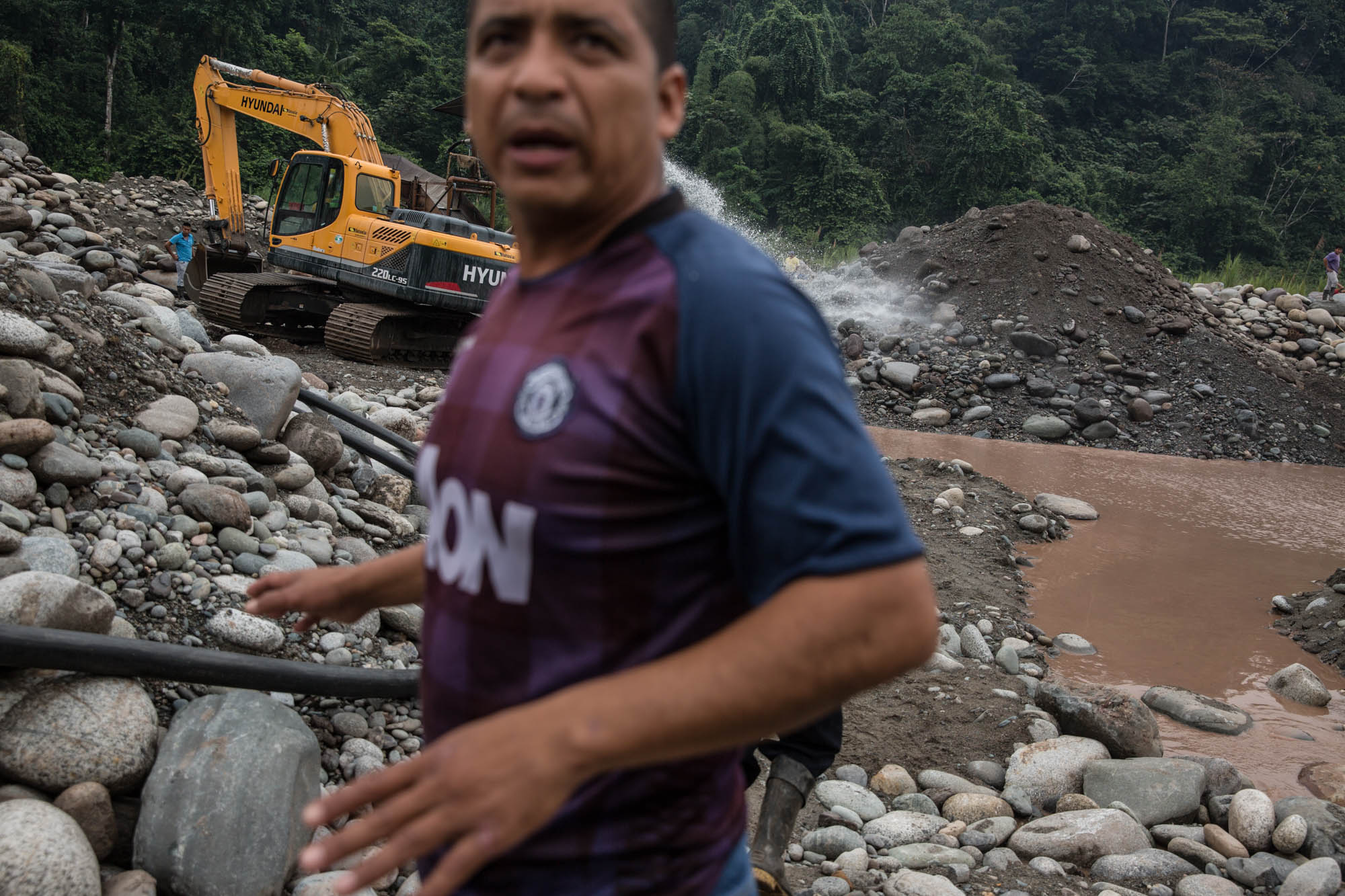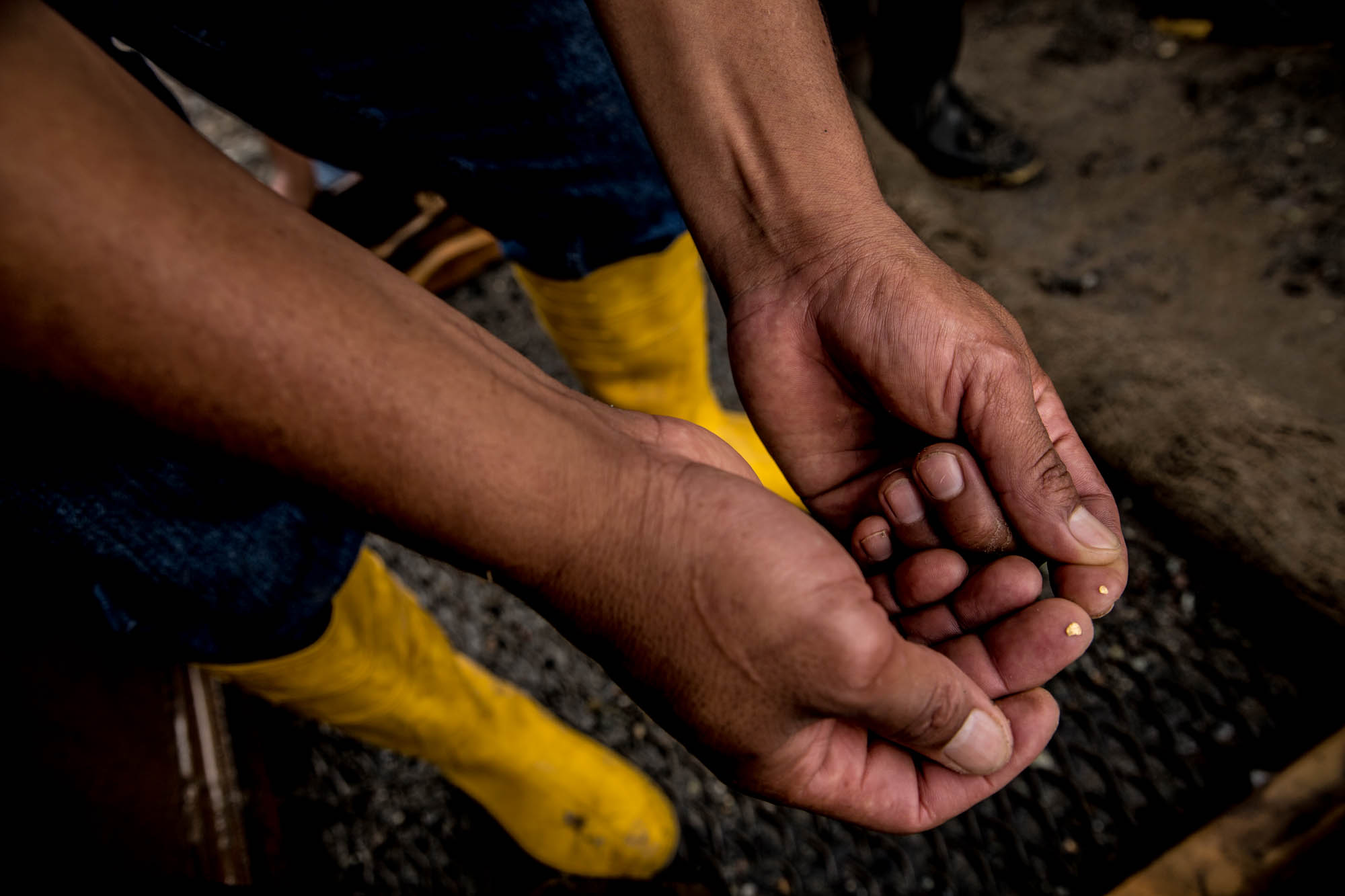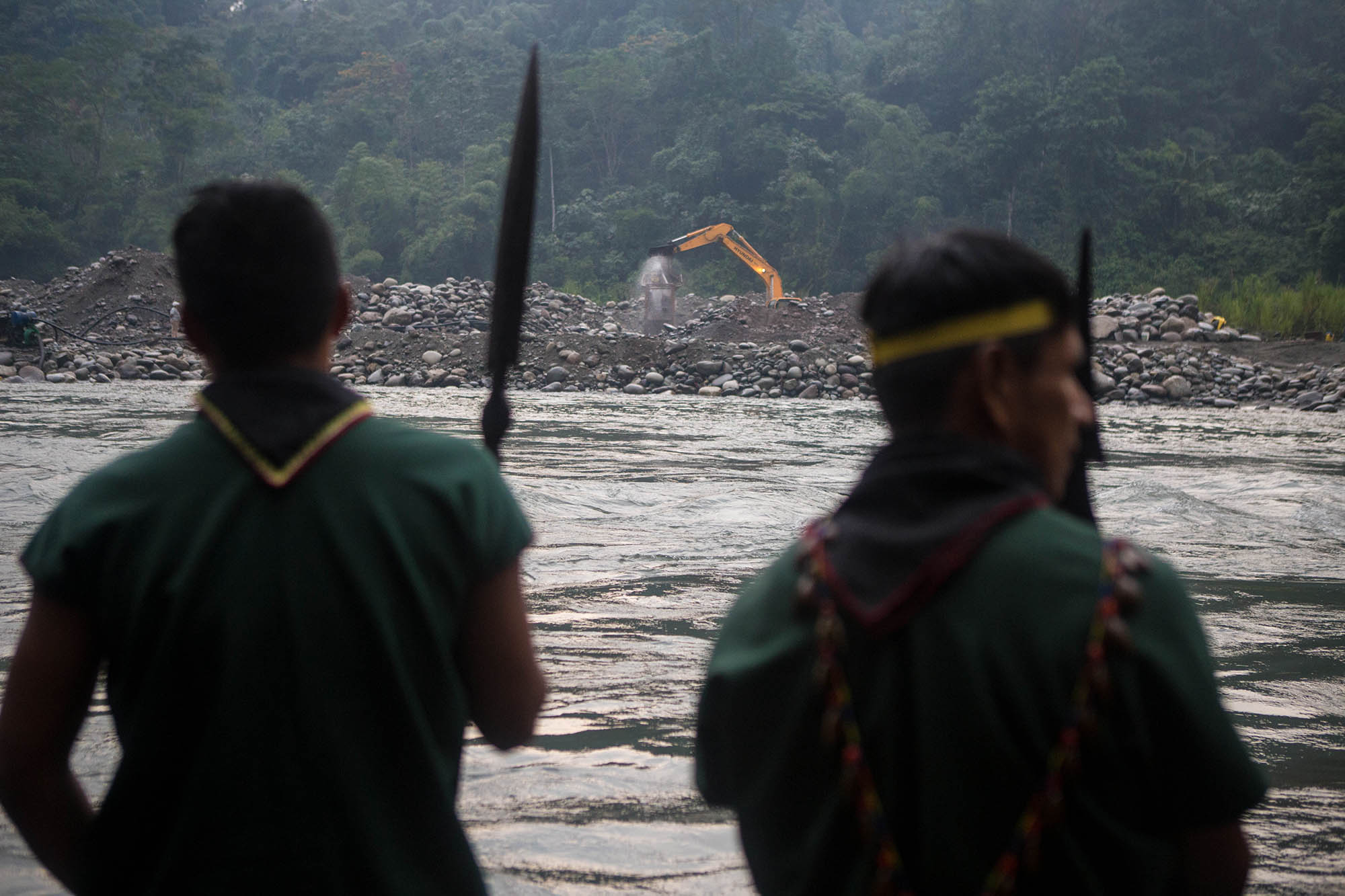Gold has been the motor of colonialism in Latin America for centuries. It began as outright theft by the first Spanish colonizers over 500 years ago, and now, when large companies operate mines, it is often dubbed “development.” In a global economy where a gram of gold is worth more than $60 USD, small-scale gold mines are proliferating. And in the Amazon, this gold rush is pushing deeper into the rainforest and Indigenous lands. Whether rubber-stamped by governments or shrouded in secrecy by wildcat miners, this gold rush feeds on mercury, a very potent neurotoxic substance, threatening inhabitants of the Amazon and especially Indigenous communities who rely on freshwater fish as a primary source of food. This article gives a quick glimpse of the mercury-related health impacts of small-scale gold mining, an activity that has hugely expanded in the Amazon since the early 2000s.
Illegal small-scale gold mining has been booming over the past years in the Ecuadorian Amazon, leaving behind dramatically damaged and polluted landscapes that will have health repercussions on local Indigenous communities for decades to come
A toxic amalgam
Looking for gold in the Amazon is like trying to find a needle in a haystack – blindfolded. Most of this precious metal is spread thinly throughout sediments and soils as tiny flecks almost invisible to the eye. To solve this scarcity and invisibility problem, miners have found a “gold magnet” that can chemically bind to gold dust, creating an amalgam. This magic lodestone – mercury – is also one of the most toxic substances on Earth, which is why it is strictly controlled under the Minamata convention that Ecuador ratified in 2016. Despite this, it is widely used throughout the Amazon. A scientific study in the Northern Ecuadorian Amazon found that 90% of small-scale miners used mercury.
Once mercury has been fixed to gold it is burned off (having a lower melting point than gold), releasing large amounts of mercury into the air. The mercury eventually deposits throughout the rainforest adding to the unknown quantities of this toxic substance that are dumped or spilled directly into ecosystems, making “artisanal” and small-scale gold mining the largest source of mercury pollution on Earth.
In Latin America, it is estimated that an average of 4.63 grams of mercury are lost for each gram of gold extracted, one of the worst ratios in the world due to the amalgamation process used. A 2020 report by the Ecuadorian Ministry of Environment concluded that at least 40% of gold is obtained through amalgamation. Using this conservative figure, the same report also estimates that 29.6 tons (29,600 kg) of mercury were released into the environment through losses per year. To give an idea of the scale of contamination, 1 gram of mercury, the amount usually contained in an old-fashioned thermometer, is enough to contaminate an 8-hectare (20-acre) lake to unsafe levels, causing mortality and impaired growth, behavior, and reproduction in fish, and representing a risk for people who consume the fish. In Ecuador alone, the amount of mercury released is enough to contaminate 29.6 million lakes of that size.
Gold mining operations on Indigenous lands detected by the A’i Cofan Guard of Sinangoe in 2018. This evidence was later used in the community’s landmark case against gold mining
Unfortunately, few studies have tried to quantify these estimates by actually measuring contamination. A study in southern Ecuador qualified the levels of mercury found in the Zamora River basin as “severely contaminated” while a study in the Northern Ecuadorian region of Cascales found that the magnitude of impact was high. Another study in the Tena region of the Northern Ecuadorian Amazon found that metal levels, including mercury, were 100 to 1000 times higher near small-scale mining than at sites farther removed and that most samples were above maximum permissible limits.
Health impacts of mercury used for gold mining
Extensive studies on the health impacts of mercury have been carried out, as this indestructible heavy metal is considered one of the most toxic substances on earth. Its main target is the brain and the nervous system, especially of fetuses and children, but it also affects the kidneys and the immune system. The well-known character, the mad hatter from Alice and Wonderland, is based on the fact that hat makers used mercury in poorly ventilated rooms to stiffen felt. This exposure impacted their brains, and their subsequent behavior was deemed madness. Mercury bioaccumulates in aquatic food chains, reaching highly toxic levels in top predators, such as the large catfish. For fish-reliant Indigenous populations of the Amazon rainforest, this is especially problematic. A new study published in January 2024 revealed patterns of heavy metal accumulation in fish from the Napo and Pastaza river basins in Ecuador, including the Aguarico, Cuyabeno and Bobonaza rivers, home to hundreds of Indigenous communities.
– The mercury used in gold mining is in its inorganic form. Miners, their families, and neighbors are exposed to this form through inhalation. Excessive quantities damage the kidneys. But that is not all. Excess mercury deposits in the environment, where much of it eventually ends up in rivers. There, mercury is converted to its organic form by bacteria and enters the food chain, whereby it travels not only through the rivers to other locations but up the food chain concentrating in top predators, such as humans. This form of mercury is toxic to the brain and nervous system at low doses. In this way, communities who are not involved in mining themselves are also affected.
A recent review of exposure to mercury covering the entire Latin American region identified the Amazon as unquestionably the area with the highest vulnerability based on the presence of small-scale gold-mining and recorded levels of this toxic metal, which are high enough to affect the normal functioning of the nervous system and decrease children’s IQ. The highest average level of mercury in a Latin American population was found among Indigenous people in the Colombia Amazon near illegal mining in the Yaigojé Apaporis national natural park.
In a region of the southern Ecuadorian Amazon where the amalgamation process is largely carried out inside houses, 26% of children had levels above those associated with adverse health impacts. In the Colombian Amazon, 24% of study participants in Indigenous communities of the Putumayo region self-reported symptoms of mercury poisoning, 84% had mercury levels deemed unsafe for pregnant women, these levels were associated with areas in which “on boat” mercury mining occurred and their fish supply, an important source of nutrition, was contaminated.

Gold mining operations on Indigenous lands detected by the A’i Cofan Guard of Sinangoe in 2018. This evidence was later used in the community’s landmark case against gold mining.
In the Madre de Dios region of the Peruvian Amazon where illegal gold mining is rampant, an association between mercury levels, malnutrition and a suppressed immune system was found among children and 37% of people tested had levels above World Health Organization’s reference level, with levels being higher in areas closer to small-scale mining. The veil of secrecy that hovers over illegal gold mining makes health communication difficult. A paper found that women with less mercury knowledge in the Madre de Dios region had higher mercury levels. Women are particularly vulnerable to negative impacts from high mercury levels because they remain the primary caregivers to children.
Taken together, the studies reviewed here point to a clear link between proximity to small-scale gold mining operations and worrisome mercury levels in Amazonian inhabitants, with evidence of adverse health impacts.
Heavy metal-related health complications and diseases are 100% avoidable. Many authors identified more regulatory policies, such as blocking imports or better monitoring, community programs, and interventions as solutions to reduce exposure for Indigenous populations in the Amazon region. But this will not be enough. As long as there is demand for gold, people somewhere will be finding cheap, quick ways to get it to market. Backing the struggles of Indigenous communities who are fighting to protect their rainforest home from this gold rush is essential to protecting their health and survival – and in turn, safeguarding our world’s largest rainforest and climate.
Indigenous community-based Guards, like the A’i Cofan of Sinangoe pictured here, patrol their lands and pair their ancestral knowledge with technology to monitor and defend their rainforest home from extractive threats like mining..
Want to find out more about how Indigenous peoples are blocking a gold rush in the Western Amazon? Watch our short documentary film, “Our Children’s River” and read the stories of A’i Cofan defenders & Goldman Prize Winners, Alexandra Narvaez & Alex Lucitante here.








